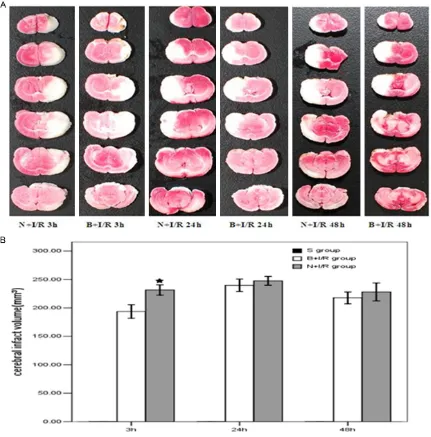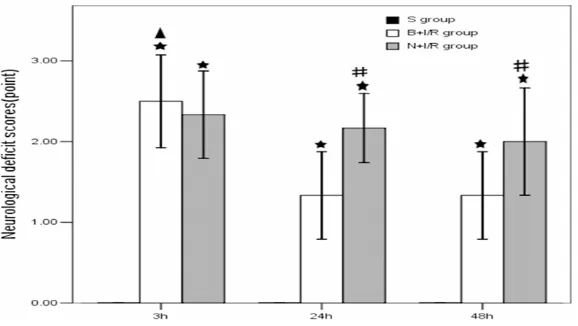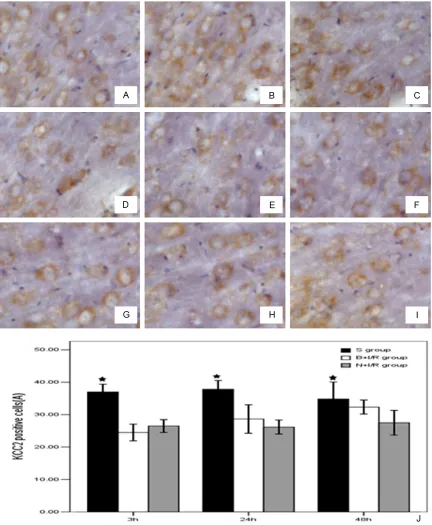Original Article
Bumetanide protects focal cerebral
ischemia-reperfusion injury in rat
Genbao Wang1,2*, Huansen Huang1, Yanbing He1*, Lin Ruan1*, Junjie Huang1
1Department of Anesthesiology, Second Affiliated Hospital of Guangzhou Medical University, Guangzhou 510260,
China; 2Department of Anesthesiology, Affiliated Zhong San Chinese Hospital of Guang Zhou Chinese University, Zhong San 528400, China. *Equal contributors.
Received January 16, 2014; Accepted February 27, 2014; Epub March 15, 2014; Published April 1, 2014
Abstract: Objective: Bumetanide has been reported to attenuate ischemia-evoked cerebral edema. However, wheth-er bumetanide can protect cwheth-erebral ischemia-repwheth-erfusion injury (IRI) in vivo is unclear. In the present study, we aim to determine whether intravenously injection bumetanide can attenuate cerebral IRI and if its protection effect might
be related to the modification of cerebral NKCC1 and KCC2 protein expression. Methods: Focal cerebral ischemia
was induced by occluding the right middle cerebral artery (MCAO) for 2-h, followed by 3-h, 24-h or 48-h of
reperfu-sion respectively. Brain edema, neurological deficits, and infarction volume were determined by (wet weights - dry
weights)/dry weights ×100, 5-point neurological function score evaluation system, and TTC staining, respectively.
The expression levels of NKCC1 and KCC2 were determined by immunohistochemical staining. Results: Reperfusion increased brain edema, neurological deficits, and infarction volume. Bumetanide decreased brain edema, attenu -ated the neurological defects and reduced post-ischemic cerebral infarction. Cerebral ischemia-reperfusion injury
increased NKCC1 expression level and decreased KCC2 expression level. Interestingly, bumetanide down-regu
-lated the NKCC1 protein expression level without changing the KCC2 protein expression level in rat brain cortex.
Conclusion: These results suggest that bumetanide protects focal cerebral ischemia-reperfusion injury in rat, which
might through the inhibition of NKCC1.
Keywords: Bumetanide, Na+-K+-Cl--cotransporter 1 (NKCC1), Na+-K+-cotransporter 2 (KCC2), cerebral
ischemia-reperfusion injury, neuroprotection
Introduction
Imbalance of ion homeostasis is a crucial mechanism leading to ischemia-induced cell damage [1]. Cation chloride co-transporters play an essential role in the regulation of neuro-nal chloride homeostasis [1-3]. The Na+-K+-Cl- -co-transporter 1 (NKCC1) and Na+-K+-co-trans- porter 2 (KCC2) belong to the cation-Cl- co-transporter family, which mediates the coupled movement of Na+ and/or K+ with Cl- across the plasma membrane of cells under physiologic conditions [1-3]. NKCC1 has a broad tissue dis-tribution, whereas KCC2 is found mainly in the nervous system [1-3]. In detail, KCC2 is pre-dominately expressed in mature neurons in the cortex, cerebellum, and the dorsal horn of the spinal cord, while NKCC1 is expressed at a high level in immature neurons [4, 5]. NKCC1 is important for the maintenance of intracellular Cl- in neurons and contributes to GABA-medi- ated depolarization in immature neurons [6, 7]
while KCC2 is the main chloride extruder in the adult nervous system [8].
In ischemic conditions, particularly after oxygen glucose deprivation in hippocampal slices [9] and in in vivo models of global ischemia [10], KCC2 is generally down-regulated while NKCC1 is up-regulated. In vitro studies have shown that bumetanide, a member of sulfamoyl benzoic acid loop diuretic family which exerts its diuretic action by blockade of the Na+-K+-2Cl cotrans- porter, significantly reduces the oxygen-glu-cose-deprivation and glutamate-mediated neu-ronal excitotoxicity and apoptosis by inhibiting NKCC1. Moreover, bumetanide has also been reported to attenuate ischemia-evoked cere-bral edema [11]. However, whether bumetanide can protect cerebral ischemia-reperfusion inju-ry (IRI) in vivo is still unclear.
Bumetanide protects cerebral ischemia-reperfusion injury
can attenuate cerebral IRI and if its protection effect might be related to the modification of cerebral NKCC1 and KCC2 protein expression.
Materials and methods
This study was conducted in accordance to the guidelines for the care and use of animals in research, and under the protocols approved by the Guangzhou University of Connecticut Animal Care and Use Committee.
Animal
Adult male rats, weighing 250~320 g (8~10 weeks), were purchased from Guangdong Province Animals Center (Guangzhou, China). Rats were anesthetized with intraperitoneal injection of 10% chloral hydrate (3.5 ml/kg body weight). Rectal temperatures were moni-tored and maintained at 37°C±0.5°C with a heating blanket and a heating lamp. Rats were randomly divided into 3 groups (n=45 per group) including sham operation group (S), saline plus ischemia reperfusion group (N+I/R group), and bumetanide plus ischemia reperfu-sion group (B+I/R group).
Rats in the B+I/R group and N+I/R group were respectively received injection of bumetanide (30 mg/kg) [12] or the same volume of saline
through tail vein 10 min before cerebral ischemia inducing. All rats except those in the sham group underwent 2-h right middle cerebral artery occlusion (MCAO) as previously report-ed [13] followreport-ed by 3-h, 24-h or 48-h reperfusion respec- tively.
Edema measurement
[image:2.612.91.381.70.265.2]Rats were decapitated un- der deep anesthesia with 10% chloral hydrate at 3-h, 24-h and 48-h of reperfu-sion. The ipsilateral and con-tralateral hemispheres were dissected and the wet weight of the tissue was deter-mined. The tissues were dried at 120°C for 24 hours. The percent cerebral water Figure 1. Bumetanide reduces brain edema after focal cerebral ischemia.
Edema in bumetanide group (B+I/R) and saline group (N+I/R) was significant
-ly higher than that in the sham group. Bumetanide significant-ly reduces brain
edema after focal cerebral ischemia. Data are expressed as means±s.d. Bu-metanide group and saline group rats, n=6; sham group rats, n=3; ★p<0.05
bumetanide and saline versus sham group. #p<0.05 versus bumetanide or
saline group.
was determined as (wet weights - dry weights)/ dry weights ×100.
Neurological evaluation
Rats were examined for neurological deficits 3-h, 24-h or 48-h after MCAO by two investiga-tors who were blinded to this study using a 5-point neurological function score [13]: 0, no deficit; 1, failure to extend right forepaw fully; 2, circling to the right; 3, failing to the right; 4, no spontaneous walking with a depressed level of consciousness. Only those rats showed no or incomplete forelimb placing with rotational asymmetry at 3-h, 24-h or 48-h after MCAO were included in the subsequent analysis [14].
TTC staining
the contralateral side with Image-J analysis software. Infarction areas on each section were summed and multiplied by section thickness to give the total infarction volume.
Immunohistochemical staining
Rat brains were removed, and postfixed in 4% paraformaldehyde overnight at 4°C, and cryo-protected with 30% sucrose in PBS. Brains were cut into coronal sections (30 um) on a freezing microtome (Leica SM 2000 R; Leica, Nussloch, Germany). Coronal sections (0.2 mm anterior to bregma) were selected and
[image:3.612.92.523.73.510.2]Bumetanide protects cerebral ischemia-reperfusion injury
(1:200; Santa Cruz, U.S.A.) for 1 hour at 37°C, followed by overnight incubation at 4°C. After rinsing, sections were incubated with goat anti-rabbit IgG (1:200; Sigma, U.S.A.) for 1 hour at 37°C. Color reaction was developed with 0.05% diaminobenzidime tetrachloride and 0.03% H2O2 in PBS (pH 7.4). Slides were visualized using a Leica SP5 confocal microscope at 40x magnification using standard procedure. All imaging was performed with group identity blinded where at least 10 random images were obtained from each slide or group.
Statistical analysis
All values are presented as means±SD. Data shown were analyzed for significance using analysis of either the nonparametric Mann-Whitney test or ANOVA by SPSS13.0 software. If a significant difference was observed, Bon- ferroni’s post-hoc test was conducted to identi-fy groups with significant differences. P-values that were less than 0.05 were considered to be statistically significant.
Results
Bumetanide reduces brain edema after focal cerebral ischemia
To determine whether bumetanide reduces edema formation resulting from MCAO, bumetanide or vehicle was administered intra-venously 10 minutes before initiation of MCAO (or sham MCAO). Bumetanide reduced the
increase of water content in ischemic brains by 33.3%, 49.7% and 45.8% respec-tively at 3-h, 24-h, and 48-h post-reperfusion (P<0.05) (Figure 1).
[image:4.612.92.381.71.234.2]Bumetanide decreases the volume of cerebral infarc-tion 3-h post-reperfusion
Figure 2 shows the repre-sentative results of TTC staining in rats subjected to N+I/R compared with rats subjected to B+I/R. The average total infarction vol-ume in saline group was 231.5±40.6 mm3 while the average total infarction vol-Figure 3. Bumetanide reduces neurological deficit scores 24-h and 48-h
post-reperfusion. Data are expressed as means±s.d. n=6. ★p<0.01 versus sham
group rats; #p<0.05 bumetanide versus saline group rats, ▲p<0.05 3-h
ver-sus 24-h and 48-h reperfusion in bumetanide group rats.
ume was reduced to 193.6±30.7 mm3 after 3-h reperfusion in the bumetanide group (p<0.05). However, the average total infarction volume was not significantly changed in the bumetanide group at 24-h, and 48-h post-reperfusion (p>0.05).
Bumetanide reduces neurological deficit scores 24-h and 48-h post-reperfusion
In the sham group, no rats have symptoms of neurological deficits while the neurological defi-cits were obvious in the saline and bumetanide group. Moreover, the neurological deficits was significantly reduced in the bumetanide group rats 24-h and 48-h post-reperfusion compared to that in the saline group (P<0.05) (Figure 3).
Bumetanide down-regulates the NKCC1 pro-tein expression level in rat brain cortex
It has been reported that the expression level of NKCC1 was increased in cortex after 24-h reperfusion following 2-h ischemia [16]. As shown in Figure 4, an enhanced immunostain-ing of the NKCC1 in neurons scattered through-out ischemic cortex 3-h, 24-h, 48-h post-reper-fusion. Compared with saline groups, pretreat-ment with bumeitanide significantly reduced the protein expression level of NKCC1.
Bumetanide does not change the KCC2 pro-tein expression level in rat brain cortex
is significantly down-regulated in the ischemic hemisphere 3-h, 24-h, and 48-h post-reperfu-sion. However, bumetanide does not change the KCC2 protein expression level in rat brain cortex (Figure 5).
Discussion
[image:5.612.92.520.69.594.2]The major findings of the present study are as follows. Firstly, bumetanide reduces brain edema after focal cerebral ischemia. Secondly, Figure 4. Bumetanide down-regulates the NKCC1 protein expression level in rat brain cortex. A-C. Respectively were
sham group rats at 3h, 24h, 48h. D-F were saline group, G-I were bumetanide groups. J. Bumetanide down-regulates
the NKCC1 protein expression level in rat brain cortex. Data are expressed as means±s.d. n=6. ★p<0.05 versus
Bumetanide protects cerebral ischemia-reperfusion injury
bumetanide decreases the volume of cerebral infarction 3-h post-reperfusion. Thirdly, bumet- anide reduces neurological deficit scores 24-h and 48-h post-reperfusion. Finally, bumetanide down-regulates the NKCC1 protein expression
level without changing the KCC2 protein expres-sion level in rat brain cortex.
NKCC1 transports Na+, K+, and Cl- into cells under both physiological and pathophysiologi-Figure 5. Bumetanide does not change the KCC2 protein expression level in rat brain cortex. A-C were the S group
3h, 24h, 48h post-reperfusion. D-F were N+I/R group 3h, 24h, 48h post-reperfusion and G-I were B+I/R group 3h,
24h, 48h post-reperfusion. J. Bumetanide does not change the KCC2 protein expression level in rat brain cortex.
[image:6.612.91.523.71.596.2]cal conditions with a stoichiometry of 1Na+: 1K+:2Cl- and it can be inhibited by either bumetanide or furosemide. Bumetanide can compete with Cl- for the second Cl- binding site and thus inhibits NKCC1 function [17-19]. After focal ischemia, extracellular K+ increases, glu-tamate is released, intracellular Ca2+ increases, excessive Na+ and Cl- accumulates, resulting in the enhancement of NKCC1 activity [20]. Pathologic activation of NKCC1 seems to be an important mechanism of cerebral edema fol-lowing ischemia. However, in certain pathologi-cal conditions, such as ischemia, hypoxia and trauma, NKCC1 expression was increased which led to cell swelling. NKCC1 has been sug-gested to play a role in K+ uptake and swelling in astrocytes [21]. In this study, we found that bumetanide reduced brain edema, decreases the volume of cerebral infarction, and reduces neurological deficit scores after focal cerebral ischemia that might be related to its inhibition effects in NKCC1.
KCC2 abundantly expresses in the adult mam-malian nervous system, and it plays an impor-tant role in maintaining the low Cl environment of mature neurons. In addition, KCC2 partici-pates in the regulation of ion balance, nerve growth and maturation, synaptic development and neuronal plasticity [22]. A decrease of KCC2 expression was previously described under ischemic conditions [9]. In the present study, we also demonstrated that KCC2 expres-sion level was down-regulated after ischemia-reperfusion in rat cerebral cortex, which is con-sistent with the previous report [23]. However, we did not observe significant changes in KCC2 expression following a single intravenous bumetanide (30 mg/kg) injection, which might be due to the fact that low concentrations of bumetanide (2~10 μM) specifically inhibits NKCC1 but does not affect KCC2 [24, 25]. Taken together, the present study suggests that bumetanide might confer its neuroprotec-tion effect mainly by inhibiting NKCC1.
In summary, cerebral ischemia-reperfusion injury increases NKCC1 expression level and decreases KCC2 expression level. Bumetanide attenuates the neurological defects and reduc-es post-ischemic cerebral infarction, which might through the inhibition of NKCC1.
Acknowledgements
This work was supported by the grants from Guang Zhou Medical University (HS. Huang).
Disclosure of conflict of interest
None to declare.
Address correspondence to: Dr. Huansen Huang,
Department of Anesthesiology, Second Affiliated
Hospital of Guangzhou Medical University, 250 Chang Gangdong Road, Guangzhou 510260, China. Tel: 0086-20-34152535; Fax: 0086-20-34152003; E-mail: huanghs5480_gz@163.com
References
[1] Haas M, Forbush B 3rd. The Na-K-Cl cotrans -porter of secretory epithelia. Ann Rev Physiol 2000; 62: 515-534.
[2] Russell JM. Sodium-potassium-chloride co-transport. Physiol Rev 2000; 80: 211-276. [3] Blaesse P, Airaksinen MS, Rivera C, Kaila K.
Cation-Chloride Cotransporters and Neuronal Function. Neuron 2009; 61: 820-838.
[4] Hebert SC, Mount DB, Gamba G. Molecular physiology of cation-coupled Cl- cotransport:
the SLC12 family. Pflugers Areh 2004; 447:
580-593.
[5] Khirug S, Yamada J, Afzalov R, Voipio J, Khir
-oug L, Kaila K. GABAergic depolarization of the
axon initial segment in cortical principal
neu-rons is caused by the Na-K-2Cl cotransporter NKCC1. J Neurosci 2008; 28: 4635-4639.
[6] Yamada J, Okabe A, Toyoda H, Kilb W, Luh -mann HJ, Fukuda A. Cl- uptake promoting
de-polarizing GABA actions in immature rat
neo-cortical neurones is mediated by NKCC1. J
Physiol 2004; 557: 829-841.
[7] Kahle KT, Simard JM, Staley KJ, Nahed BV,
Jones PS, Sun D. Molecular mechanisms of ischemic cerebral edema: role of electroneu-tral ion transport. Physiology (Bethesda) 2009; 24: 257-265.
[8] Rivera C, Voipio J, Payne JA, Ruusuvuori E,
La-htinen H, Lamsa K, Pirvola U, Saarma M, Kaila K. The K–C co-transporter kcc2 rendersgaba
hyperpolarizing during neuronal maturation. Nature 1999; 397: 251-255.
[9] Galeffi F, Sah R, Pond BB, George A,
Schwartz-Bloom RD. Changes in intracellular chloride after oxygen-glucose deprivation of the adult hippocampal slice: Effect of diazepam. J Neu-rosci 2004; 24: 4478-4488.
[10] Papp E, Rivera C, Kaila K, Freund TF. Relation -ship between neuronal vulnerability and potas-sium-chloride cotransporter 2 immunoreactiv-ity in hippocampus following transient fore- brain ischemia. Neurosci 2008; 154: 677-689.
Bumetanide protects cerebral ischemia-reperfusion injury
neuronal damage. Eur J Pharmacol 2006; 548: 99-105.
[12] Liu Y, Shangguan Y, Barks JD, Silverstein FS. Bumetanide augments the neuroprotective
ef-ficacy of phenobarbital plus hypothermia in a
neonatal hypoxia-ischemia model. Pediatr Res 2012; 71: 559-565.
[13] Longa EZ, Weinstein PR, Carlson S, Cummins R. Reversible middle cerebral artery occlusion without craniectomy in rats. Stroke 1989; 20: 84-91.
[14] Thored P, Wood J, Arvidsson A, Cammenga J,
Kokaia Z, Lindvall O. Long-term neuroblast mi -gration along blood vessels in an area with transient angiogenesis and increased vascu-larization after stroke. Stroke 2007; 11: 3032-3039.
[15] Swanson RA, Morton MT, Tsao-Wu G, Savalos RA, Davidson C, Sharp FR. A semiautomated method for measuring brain infarct volume. J Cereb Blood Flow Metab 1990; 10: 290-293. [16] Yan Y, Dempsey RJ, Sun D. Na+-K+-Cl- con
-transporter in rat focal cerebral ischemia. J Cereb Blood Flow Metab 2001; 21: 711-721. [17] Yan Y, Dempsey RJ, Flemmer A, Forbush B, Sun
D. Inhibition of Na+-K+-Cl- cotransporter dur -ing focal cerebral ischemia decreases edema and neuronal damage. Brain Res 2003; 961: 22-31.
[18] Chen H, Luo J, Kintner DB, Shull GE, Sun D. Na+-dependent chloride transporter
(NKCC1)-null mice exhibit less gray and white matter damage after focal cerebral ischemia. J Cereb Blood Flow Metab 2005; 25: 54-66.
[19] Forbush B 3rd, Palfrey HC. [3H]bumetanide binding to membranes isolated from dog
kid-ney outer medulla. Relationship to the Na,K, Cl
co-transport system. J Biol Chem 1983; 258: 11787-11792.
[20] O’Donnell ME, Tran L, Lam TI, Liu XB, Anderson SE. Bumetanide inhibition of the blood-brain
barrier Na-K-Cl cotransporter reduces edema
formation in the rat middle cerebral artery oc-clusion model of stroke. J Cereb Blood Flow Metab 2004; 24: 1046-1056.
[21] Su G, Haworth RA, Dempsey RJ, Sun D.
Regula-tion of Na(+)-K(+)-Cl(-) cotransporter in primary astrocytes by dibutyryl cAMP and high [K(+)]
(o). Am J Physiol 2000; 279: C1710-21. [22] Payne JA, Rivera C, Voipio J, Kaila K.
Cation-chloride co-transporters in neuronal communi-cation, development and trauma. Trends Neu-rosci 2003; 26: 199-206.
[23] Jaenisch N, Witte OW, Frahm C.
Downregula-tion of potassium chloride cotransporter KCC2
after transient focal cerebral ischemia. Stroke 2010; 41: e151-e159.
[24] Gillen CM, Brill S, Payne JA, Forbush B 3rd. Mo-lecular cloning and funetional expression of
the K-Cl cotransporter from rabbit, rat, and hu -man. A new member of the cation-chloride co-transporter family. J Biol Chem 1996; 271: 16237-1624.
[25] Tyzio R, Cossart R, Khalilov I, Minlebaev M, Hubner CA, Represa A, Ben-Ari Y, Khazipov R.




